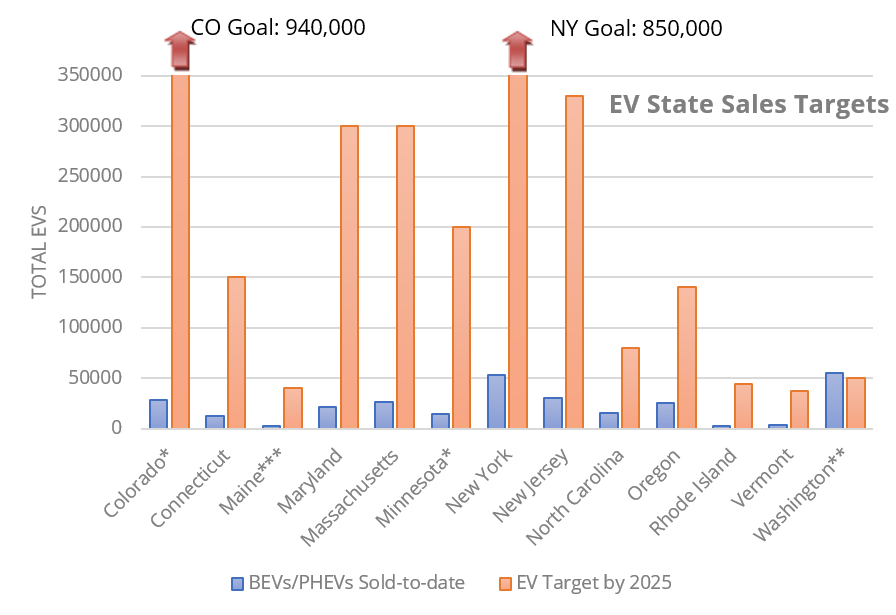This paper includes recommendations to help Governors meet their EV goals and provides strategies that can improve the interplay between EVs and the electric grid.
Executive Summary
Transportation electrification is growing across the country and Governors are taking steps to advance electric vehicle (EV) adoption and prepare for the increasing interactions between EVs and the electric grid. Governors in 14 states have set electric vehicle goals and are planning a transition to EVs. Additionally, 15 Governors recently signed a memorandum of understanding (MOU) to commit their states to eliminate medium and heavy-duty vehicle emissions by 2050. A key challenge for states is how to meet EV charging needs and, as charging networks are built out, how to manage impacts to the electricity grid. This issue brief will explore the following topics:
- Installing Charging Infrastructure. Locating chargers in strategic locations, often referred to as siting, to provide convenient access to EV drivers can smooth demand impacts on the electric grid.
- Vehicle Grid Integration (VGI) or Managed Charging. EVs allow for flexible fueling, enabling them to be more responsive to grid demands and constraints. Appropriate vehicle-grid integration can enable cost savings and ensure a reliable electric grid. VGI strategies include integrating smart charging controls and designing responsive electric utility rate structures.
- Vehicle-to-Grid (V2G). EVs have further capacity to feed electricity back to the grid, allowing for bidirectional energy flow, known as vehicle-to-grid (V2G). This technology is not fully implemented; there are pilot projects underway in parts of the U.S. V2G may provide additional benefits such as cost savings for utilities and customers, while improving grid resilience and reliability.
Impacts to the electric grid remain low as EV adoption remains close to 2 percent of all light-duty vehicles in the country. However, it is important for states to begin preparing for an increasing trend in transportation electrification. Many actions are available to Governors that can help smooth this transition as more EVs are on the road. Some potential steps include establishing an EV working group to plan for this transition; collaboration with other Governors to build out charging networks among interstate corridors; or instructing regulators to consider EV rate pilot programs. States can consider these actions as they move to an electrified transportation system.
“As we continue to move towards a cleaner electric grid, the public-health and environmental benefits of widespread transportation electrification will only increase.”
Colorado Governor Jared Polis
Introduction
The transportation sector is rapidly evolving as electric vehicles, including both battery-electric vehicles (BEVs) and Plug-in Hybrid Electric Vehicles (PHEVs), grow in popularity, costs decline, and EV technology advances. While projections vary, and there may be a temporary slowing in growth due to the economic impacts from COVID-19, EVs are expected to make up 20 percent of annual vehicle sales by 2030 with more than 18.4 million total vehicles sold. Governors have committed to reaching nearly 8.5 million EVs on the road by 2030 (See Figure 1). California and New Jersey have recently called for all vehicle sales to be zero emission vehicles by 2035. At the beginning of 2020, there were nearly 1.5 million EVs in the U.S. Battery costs have also fallen 87 percent since 2010 to an average market price of $156/kWh, with projections to fall to $100/kWh by 2023. These steady price decreases are edging EVs towards cost parity with internal combustion energy vehicles, which is estimated to be around $100/kWh.
Through new executive actions and legislation, Governors’ commitments are expected to further advance EV adoption. However, increasing numbers of EVs may have impacts on the electric grid. Installing charging infrastructure faces potential challenges including:
- Higher costs, particularly for DC fast chargers,
- Consumer awareness of both available chargers and rebate programs, and
- Exacerbated energy peaks by increased electricity demand from EVs
This paper includes recommendations to help Governors meet their EV goals and provides strategies that can improve the interplay between EVs and the electric grid.

- * = Target date is 2030
- ** = Target date is 2020 *Met Goal* – New goal is 300,000 EVs by 2025, all ZEV by 2050
- *** = Vehicle sales goal is an estimate, true goal is 15.4% of vehicle sales in 2025
- Due to scaling purposes, California is not included in the above graph. As of June 2020, the state had 726,000 EVs on roads, and a target of 5 million EVs by 2025.












